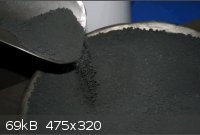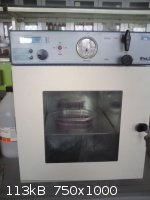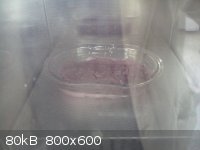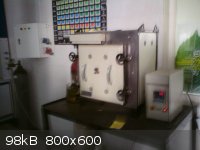Waffles SS
Fighter
   
Posts: 998
Registered: 7-12-2009
Member Is Offline
|
|
Cobalt (II) Hydroxide
| Quote: |
Cobalt(II) Hydroxide.
Co(OH)2 (63.43%Co) is prepared commercially as a pink solid
by precipitation from a cobalt(II) salt solution with sodium hydroxide. It has a hexagonal crystal structure with a = 0.317 nm and c/a = 1.46. It is
insoluble in water and alkaline solutions,
but dissolves readily in most inorganic and organic acids; for this reason, it is commonly used as a starting material in the synthesis of cobalt
chemicals. Co(OH)2 decomposes thermally by
loss of water, starting at 150 ◦C, to give the anhydrous oxide at 300 ◦C. Care must be taken to store the hydroxide in the absence of air
because slow air oxidation leads to a product that is poorly soluble in weak acids.
Ullmann's Enc. of Industrial Chemistry
|
| Quote: |
Cobalt(II) hydroxide is precipitated when an alkaline hydroxide is added to an aqueous solution of Co2+ ions:
CoCl2 (aq) + 2 NaOH → Co(OH)2 (s) + 2 NaCl
Cobalt(II) hydroxide decomposes to cobalt(II) oxide at 168 °C under vacuum and is oxidized by air to form cobalt(III) hydroxide, Co(OH)3.[1] The
thermal decomposition product in air above 300 °C is Co3O4
http://en.wikipedia.org/wiki/Cobalt%28II%29_hydroxide
|
I want to make Cobalt (II)Hydroxide but it seems it will oxidize to Cobalt(III)hydroxide by air and i should use inert condition.
Somebody know how long maybe take for this oxidation?it happen slowly(as ullmann wrote)?This is possible to separate it fast from solution?
|
|
|
blogfast25
International Hazard
    
Posts: 10562
Registered: 3-2-2008
Location: Neverland
Member Is Offline
Mood: No Mood
|
|
This oxidation is indeed quite slow. Simply work fast, if other Co (II) salts are your goal.
|
|
|
Waffles SS
Fighter
   
Posts: 998
Registered: 7-12-2009
Member Is Offline
|
|
Thanks blogfast25,
Unfortunately my goal is Co(OH)2
I saw different video on youtube.com about reaction of Sodium Hydroxide with Cobalt Chloride and really i confused about result.I think solution color
of Co(OH)2 should be rose red but in these video another colors appear.
What is color of Cobalt(II) hydroxide solution(slurry)
www.youtube.com/watch?v=ehPjfpY4jcs
www.youtube.com/watch?v=XWwvEyY1dgU
www.youtube.com/watch?v=fenRryFGRw8
Quote: Originally posted by woelen  |
The problem with all these precipitating alkaline methods is that contamination with cobalt (III) is very hard to avoid. In my experience, cobalt (II)
is EXTREMELY easily oxidized by oxygen from air, as soon as a precipitate is made at high pH, and also in the presence of many ligands. E.g. a
precipitate of Co(OH)2 is oxidized by air in a matter of seconds. Probably the same will happen with carbonate precipitates.
|
Matter of seconds?
| Quote: |
Sodium hydroxide first precipitates the basic salt just described. This basic salt is insoluble in excess sodium hydroxide, but is soluble in acids.
When heated, the basic salt hydrolyzes to form Co(OH)2. Cobalt(II) hydroxide is slowly oxidized by atmospheric oxygen to form brown Co(OH)3.
http://www.public.asu.edu/~jpbirk/qual/qualanal/cobalt.html
|
It seems i should warm solution(CoCl2 and NaOH) for making Co(OH)2.am i wrong?
[Edited on 29-1-2013 by Waffles SS]
[Edited on 29-1-2013 by Waffles SS]
|
|
|
woelen
Super Administrator
        
Posts: 8012
Registered: 20-8-2005
Location: Netherlands
Member Is Offline
Mood: interested
|
|
My experience with cobalt hydroxide is that it indeed quickly oxidizes. If you have a suspension of cobaltous hydroxide in water, then it quickly
turns brown instead of pink. It is not a matter of seconds, but in two minutes or so the precipitate becomes covered by a brown layer. So, you indeed
have to work fast!
Another effect is that first the precipitate is blue and it turns pink after some time. The speed of conversion depends on the concentration of the
alkali, used to make the precipitate (see page below with pictures).
http://woelen.homescience.net/science/chem/solutions/co.html
|
|
|
Waffles SS
Fighter
   
Posts: 998
Registered: 7-12-2009
Member Is Offline
|
|
Thanks Woelen for your help and your beautiful pictures,
I have Cobalt(II)Oxide and i want to make Cobalt(II) Hydroxide.First i should make Cobalt(II)Salt and then react this solution with NaOH.
At first Making Cobalt(II) Sulfate from oxide is good choice or better i make Cobalt(II)Chloride ?
It seems i should work in inert condition but what about dissolved oxygen in water?I should remove it?
What about solid Cobalt(II)Hydroxide?it will oxidize by air as quickly as it suspension?
[Edited on 29-1-2013 by Waffles SS]
|
|
|
woelen
Super Administrator
        
Posts: 8012
Registered: 20-8-2005
Location: Netherlands
Member Is Offline
Mood: interested
|
|
When the cobalt(II) hydroxide is dry, then it is much less prone to oxidation. The wet material is very sensitive.
Do you really have cobalt(II) oxide or the black Co3O4 (mixed II, III oxide)? The latter is very inert and hard to dissolve. I have some and it is a
real pain in the ass to get it dissolved. But if you can get your material dissolved, then indeed dissolve it in dilute (preferrably) sulphuric acid
and then add some solution of NaOH to this solution, such that a precipitate is formed. Add a slight excess of solution of NaOH. After this you need
to rinse very well with boiled water (this contains less oxygen than plain water) in order to get rid of entrapped sodium ions and sulfate ions. I
expect the formed Co(OH)2 to be only moderately pure, most likely it still will contain quite some sodium and sulfate ions which are coprecipitated.
If you use HCl instead of H2SO4 then I expect much more contamination. Chloride ions form a complex with cobalt(II) quite easily (deep blue, it is on
the web page I gave above) and in the precipitate with chloride ions you'll get a lot of oxychloride contamination. Sulfate and nitrate ions are
better for this purpose.
|
|
|
LanthanumK
Hazard to Others
  
Posts: 298
Registered: 20-5-2011
Location: New Jersey
Member Is Offline
Mood: No Mood
|
|
I have created cobalt(II) hydroxide several times and I have not noticed aerial oxidation happening in the span of an hour or so. Only the addition of
oxidizers like hydrogen peroxide or sodium hypochlorite forms brown cobalt(III) compounds.
hibernating...
|
|
|
blogfast25
International Hazard
    
Posts: 10562
Registered: 3-2-2008
Location: Neverland
Member Is Offline
Mood: No Mood
|
|
Quote: Originally posted by LanthanumK  | | I have created cobalt(II) hydroxide several times and I have not noticed aerial oxidation happening in the span of an hour or so. Only the addition of
oxidizers like hydrogen peroxide or sodium hypochlorite forms brown cobalt(III) compounds. |
Yup, that's kind of my experience too.
|
|
|
Waffles SS
Fighter
   
Posts: 998
Registered: 7-12-2009
Member Is Offline
|
|
My Cobalt Oxide is black and i dont know what type of Cobalt Oxide is that, (II) or (III) or mixed.
Is there easy way for finding out which one is that?(checking density?)
In the mentioned youtube.com video i saw oxidation occur at surface after short time and brown color appeared
[Edited on 30-1-2013 by Waffles SS]
|
|
|
woelen
Super Administrator
        
Posts: 8012
Registered: 20-8-2005
Location: Netherlands
Member Is Offline
Mood: interested
|
|
Cobaltous hydroxide, suspended in water does not oxidize at once, but the material, sticking to the glass becomes brown quickly. If the material is
filtered, then the outer layer, exposed to air also is oxidized quickly. So, in practice it is quite hard to obtain a nice dry product without
oxidation.
The black oxide is most likely the mixed II, III oxide. You can easily test this. Add some of this powder to dilute sulphuric acid and heat the liquid
somewhat. Does it dissolve quickly or does it hardly react? Mine is very inert and even boiling for ten minutes in 20% H2SO4 does not give a
noticeable color to the solution. The liquid becomes black due to finely dispersed oxide, but after a minute or so the liquid is colorless again and a
layer of black oxide settles at the bottom.
I obtained a very pale pink solution with dilute HCl to which some sodium sulfite was added as reductor to reduce the cobalt(III) to cobalt(II). This
required boiling for several minutes and slowly adding small amounts of sulfite.
|
|
|
Waffles SS
Fighter
   
Posts: 998
Registered: 7-12-2009
Member Is Offline
|
|
Similar Fe2O3.I tried reaction of Iron(III)Oxide with boiling mineral acids but no one cant dissolve it(just boiling HCl dissolve small amount of
it).I think Mixed Cobalt II,III is inert too and i should try boiling HCl solution for it.
arent Cobalt(III) compounds unstable?
Somebody know how much industrial Cobalt Hydroxide cost?I think it should be more expensive than Cobalt Oxides and chloride
[Edited on 31-1-2013 by Waffles SS]
|
|
|
woelen
Super Administrator
        
Posts: 8012
Registered: 20-8-2005
Location: Netherlands
Member Is Offline
Mood: interested
|
|
Cobalt(III) compounds with free or simply hydrated cobalt(III) ion indeed are very unstable and are very strong oxidizers. The presence of certain
ligands, however, stabilizes cobalt(III) enormously, so much even that in many cases the cobalt(II) species becomes the unstable one, which very
easily is reduced.
E.g. if you add ammonia to a solution of a cobalt(II) salt, then you first get a complex of cobalt(II), but within seconds the surface of the liquid
and the liquid sticking to the glass obtains a red/brown color, due to formation of a cobalt(III) complex of ammonia. The same is true for
cyanide-ligands. The salt K3Co(CN)6 is a very stable pale yellow salt (I have some of this), while salts of [Co(CN)6](4-) are so reactive that they
hardly can be kept around, except when stored under inert atmosphere and only can be prepared in special air-free apparatus.
I do not know of industrial grade cobaltous hydroxide, I have never seen it in the list of any seller, but of course that does not mean it cannot be
purchased. But I do think that it is much harder to obtain than many other cobaltous salts like the carbonate, chloride or sulfate.
|
|
|
Waffles SS
Fighter
   
Posts: 998
Registered: 7-12-2009
Member Is Offline
|
|
Thanks woelen,
I found out My cobalt Oxide is Co2O3.CoO(Co3O4). 
I have any chance even with boiling nitric acid or hydrochloric acid?Did you success in making Co(II)with your mixed cobalt oxide(II ,III)?
[Edited on 31-1-2013 by Waffles SS]
|
|
|
woelen
Super Administrator
        
Posts: 8012
Registered: 20-8-2005
Location: Netherlands
Member Is Offline
Mood: interested
|
|
I never managed to obtain cobalt(II) salts in more than trace amounts from the Co3O4 I have. I have boiled it in H2SO4, conc. HCl and reducing
environments made of H2SO4 and NaHSO3 or HCl and NaHSO3. Best results were obtained with HCl and NaHSO3, but even with this, after several minutes of
boiling I only obtained a very weak solution (nearly colorless) and the amount of oxide was not visibly reduced.
The black oxide is very inert and you probably must resort to molten salts in order to get it dissolved (e.g. molten glass or molten sodium borate).
Isolating the cobalt from this is not easy though. My Co3O4 is somewhere sitting in a bottle, stowed away out of sight and I did not touch this bottle
for at least a few years anymore. I instead obtained CoCO3 and CoSO4.xH2O.
|
|
|
LanthanumK
Hazard to Others
  
Posts: 298
Registered: 20-5-2011
Location: New Jersey
Member Is Offline
Mood: No Mood
|
|
Cobalt oxide solubility
I have heated freshly precipitated pink cobalt(II) carbonate until it oxidized to black cobalt oxide. Placement in muriatic acid caused a light green
cobalt(II) coordination complex to form after a day, which upon exposure to air evaporated to form a tiny amount of cobalt(II) chloride crystals. As
you can see, the vast majority of the cobalt oxide remained unreacted, even after further treatment with muriatic acid.

[Edited on 1-2-2013 by LanthanumK]
hibernating...
|
|
|
Waffles SS
Fighter
   
Posts: 998
Registered: 7-12-2009
Member Is Offline
|
|
Thanks @woelen and @LanthanumK ,
Today i found another industrial Cobalt oxide that use in glaze and ceramic.I think it should be CoO.isnt it?
@LanthanumK i think you made Co3O4.
3 CoCO3 + 1/2 O2 → Co3O4 + 3 CO2
Did you mix it with boiling muriatic acid?
|
|
|
LanthanumK
Hazard to Others
  
Posts: 298
Registered: 20-5-2011
Location: New Jersey
Member Is Offline
Mood: No Mood
|
|
No, it was room temperature HCl used for the dissolution.
Cobalt(II) oxide is used as a coloring agent, per the Wikipedia article.
As also mentioned in the Wikipedia article, I also made cobalt(II) oxide through electrolysis of cobalt(II) chloride solution. Here is a picture of
the stuff. It is not as black as cobalt(II,III) oxide.

hibernating...
|
|
|
Waffles SS
Fighter
   
Posts: 998
Registered: 7-12-2009
Member Is Offline
|
|
@LanthanumK ,
It seems your CoO is dark brown and is not black.
Did you react your Cobalt(II)oxide with acids?Did it react fast?
I attach my new Cobalt Oxide Picture.its really black(i dont know that is II or II,III)

In the below page you can see details of my cobalt oxide.It contain 71-72% Co but i think for CoO it should be 78%(what is it?Co2O3?)
http://www.nicomet.com/cobalt.htm
[Edited on 1-2-2013 by Waffles SS]
|
|
|
Waffles SS
Fighter
   
Posts: 998
Registered: 7-12-2009
Member Is Offline
|
|
Picture of wet Cobalt(II) Hydroxide in Vacuum Oven


|
|
|
LanthanumK
Hazard to Others
  
Posts: 298
Registered: 20-5-2011
Location: New Jersey
Member Is Offline
Mood: No Mood
|
|
As long as the cobalt(II) oxide is not heated too strongly, it easily dissolves in HCl.
hibernating...
|
|
|
AJKOER
Radically Dubious
    
Posts: 3026
Registered: 7-5-2011
Member Is Offline
Mood: No Mood
|
|
Here are some comments on Co(OH)2 from http://cobalt.atomistry.com/ :
"With alkalis, its salts yield a blue-violet precipitate of cobalt hydroxide, Co(OH)2, which is converted into its anhydride, green cobaltous oxide,
CoO, on being heated out of contact with oxygen. At a red heat it takes up oxygen from the air, and an oxide, Co3O4, corresponding to magnetic iron
ore, is formed, which is again converted into the monoxide at a white heat.
Cobalt hydroxide does not dissolve in excess of alkalis (except in traces, when the solutions are very concentrated), but readily does so in solutions
of ammonium salts. The reaction is, in the first instance, similar to that in the case of magnesium hydroxide; but if a large excess of ammonia is
added, the red colour changes to a yellow-brown, which shows that a new, complex compound has been formed. If the liquid is diluted with much water,
blue cobalt hydroxide separates out as a flocculent precipitate. As in the case of manganese, the ammoniacal solution absorbs oxygen from the air,
whereby complex salts are formed which will be mentioned later. "
|
|
|
Waffles SS
Fighter
   
Posts: 998
Registered: 7-12-2009
Member Is Offline
|
|
I put my cobalt Oxide(II ,III) on Furnace at 1000c under nitrogen for 30 minutes.
According to wikipedia it should turn to CoO.isnt it?
| Quote: |
Cobalt(II,III) oxide decomposes to cobalt(II) oxide at 950 °C:[6]
2 Co3O4 → 6 CoO + O2
http://en.wikipedia.org/wiki/Cobalt(II)_oxide
[6]US 4389339, James, Leonard E.; Crescentini, Lamberto & Fisher, William B., "Process for making a cobalt oxide catalyst"
|

My Furnace picture
[Edited on 11-2-2013 by Waffles SS]
|
|
|